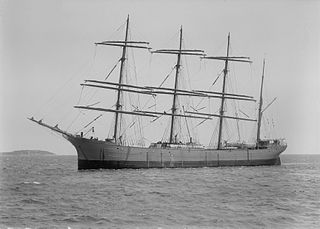
SS Robin is a 350 gross registered ton (GRT) steam coaster, a class of steamship designed for carrying bulk and general cargoes in coastal waters, and the oldest complete example in the world. One of a pair of coasters built in Bow Creek, London in 1890, the ship was built for British owners, but spent most of her long working life on the Spanish coast as Maria.
HMS Western Isles was a command ship of the Royal Navy during World War II, serving as the flagship of the Anti-Submarine Training School at Tobermory on the Isle of Mull under Vice Admiral Gilbert Stephenson. Launched in 1902 as the Dutch Batavier Line passenger ship Batavier IV, after the war she served in the Royal Netherlands Navy as the training ship Hr. Ms. Zeearend. She was decommissioned in 1970, and scrapped in 1972.

Lawhill was a steel-hulled four-masted barque rigged in "jubilee" or "baldheaded" fashion, i.e. without royal sails over the top-gallant sails, active in the early part of the 20th century. Although her career was not especially remarkable, save perhaps for being consistently profitable as a cargo carrier, in the 1930s Richard Cookson went on board and extensively documented Lawhill's internals and construction, which was later published in the Anatomy of the Ship series.

SS Batavier V was a steam packet for the Batavier Line that sailed between Rotterdam and London for most of her career. The ship was built in 1897 by the Gourlay Brothers of Dundee. The Dutch ship could carry a limited amount of freight and up to 428 passengers. She was rebuilt in 1909 which increased her length by over 5 metres (16 ft).
Gourlay Brothers was a marine engineering and shipbuilding company based in Dundee, Scotland. It existed between 1846 and 1908.
SS Bonnie Dundee was a 193/121-gross-ton Australian steamship which sank after a collision with the steamship SS Barrabool off Lake Macquarie, New South Wales, Australia, on 10 March 1879.

The Burntisland Shipbuilding Company was a shipbuilder and repairer in Burntisland, Fife, Scotland that was founded in 1918. In 1969 it was taken over by Robb-Caledon Shipbuilders, which in turn was nationalised in 1977 as part of British Shipbuilders.

This article describes the shipping services of the London and South Western Railway and the vessels employed.

The SS Yarmouth was a steel-hulled steamship owned by the Great Eastern Railway. She was built in 1903 for use on their cargo service between Harwich, Essex, and the Hook of Holland and Rotterdam, the Netherlands. She was lost at sea with all hands on 27 October 1908.
SS Melmore was a passenger cargo vessel operated by the Great Western Railway from 1905 to 1912.
TSS Atalanta was a passenger vessel built for the London and South Western Railway in 1907.
SS Nidd was a freight vessel built for the Goole Steam Shipping Company in 1900.
SS Equity was a freight vessel built for the Co-operative Wholesale Society Limited in 1888.
SS Cuxhaven was a cargo ship built for the Yorkshire Coal and Steamship Company in 1882.
SS Altona was a freight vessel built for the Yorkshire Coal and Steamship Company in 1877. The ship was scrapped in 1927.
PS Norfolk was a passenger vessel built for the Great Eastern Railway in 1900.

TSS Cromer was a cargo vessel built for the Great Eastern Railway in 1902.
PS Cleethorpes was a passenger and cargo vessel built for the Great Central Railway in 1903.
SS Bertha was a cargo vessel built for the London and South Western Railway in 1905.
TSS Princess Ena was a passenger vessel built for the London and South Western Railway in 1906.






